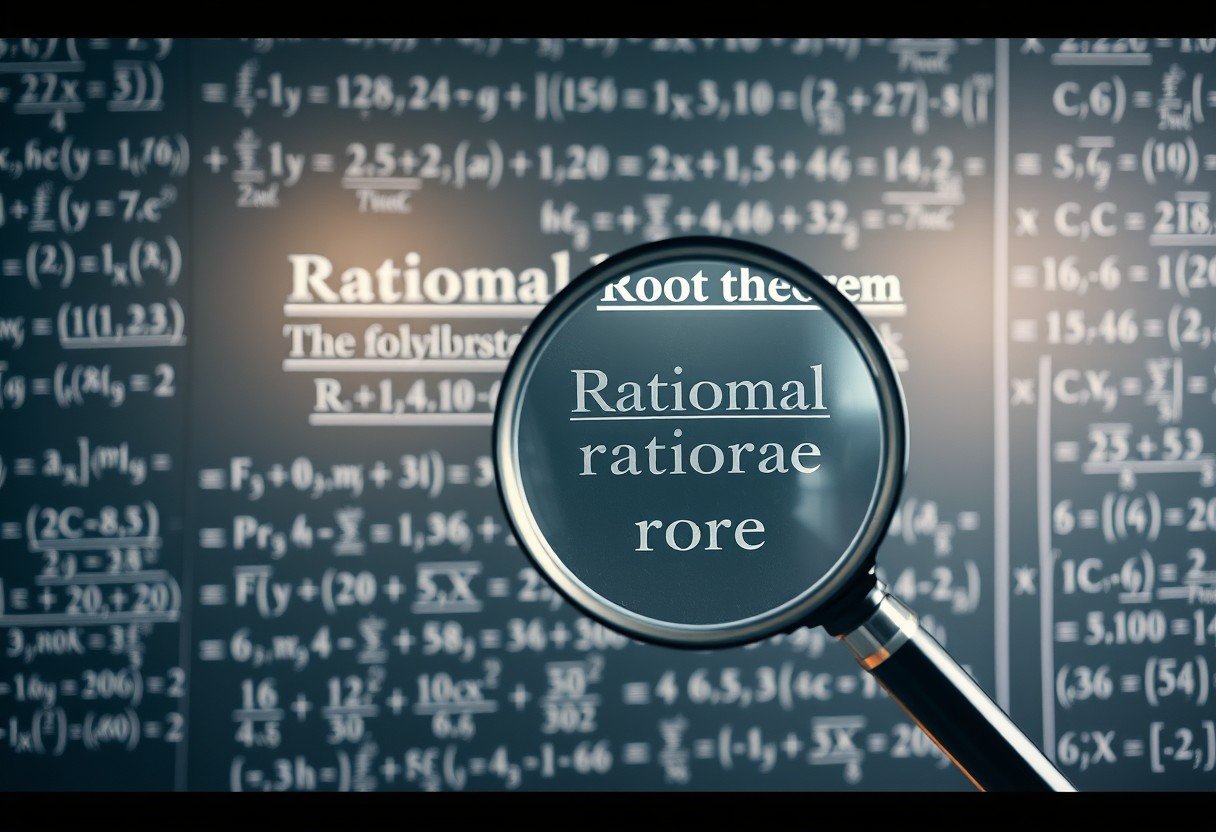Have you ever stared at a long polynomial equation and wondered where to even begin finding its solutions? The Rational Root Theorem is a powerful algebraic tool that gives you a starting point. It helps you create a list of all possible rational roots (solutions that can be written as fractions), turning a daunting problem into a manageable process of testing and discovery.
What exactly is the Rational Root Theorem?
In simple terms, the Rational Root Theorem provides a clear method for finding potential rational solutions for a polynomial equation with integer coefficients. It creates a direct link between the polynomial’s constant term (the number without a variable) and its leading coefficient (the number in front of the variable with the highest power).
The theorem states that if a polynomial has a rational root that can be expressed as a fraction p/q, then p must be a factor of the constant term, and q must be a factor of the leading coefficient. This is the core principle that allows you to build a list of candidates.
Understanding this rule is essential because it dramatically narrows down your options. Instead of guessing randomly from an infinite number of possibilities, you have a finite, specific list of numbers to test, making the process of solving polynomial equations much more efficient.
How to Find Potential Rational Roots Step by Step
Using the theorem is a systematic process. By following a few clear steps, you can generate a complete list of all possible rational roots for any given polynomial. This organized approach prevents you from missing any potential solutions.
Before you begin, make sure your polynomial is written in standard form, from the highest power of x down to the constant term. This makes identifying the necessary components straightforward.
Here is the step-by-step method to apply:
- Identify the constant term and the leading coefficient. The constant term is the number without a variable, and the leading coefficient is the number attached to the variable with the highest exponent.
- List all integer factors of the constant term. These will be your possible values for ‘p’. Remember to include both positive and negative factors.
- List all integer factors of the leading coefficient. These will be your possible values for ‘q’. Again, include both positive and negative factors.
- Create all possible fractions of the form ±p/q. This complete list contains every potential rational root of the polynomial.
Once you have this list, you are ready to start testing the candidates to see which ones are actual roots.
Applying the Theorem with a Practical Example
Let’s see how this works with a real polynomial, such as f(x) = 2x³ – 3x² + 5x – 6. Following the theorem helps us break this problem down into simple, manageable parts.
First, we identify our key components. The constant term is -6, and the leading coefficient is 2.
Next, we list the factors for each.
- Factors of the constant term (-6) are: ±1, ±2, ±3, ±6. These are the possible ‘p’ values.
- Factors of the leading coefficient (2) are: ±1, ±2. These are the possible ‘q’ values.
Finally, we form all possible fractions by dividing each ‘p’ value by each ‘q’ value. This methodical process gives us a finite list of potential rational roots to check. The potential roots are ±1, ±2, ±3, ±6, ±1/2, and ±3/2.
Tools for Testing Your Potential Roots
Creating the list of potential roots is only half the battle. The next step is to test these candidates to determine which, if any, are actual roots of the function. Fortunately, there are efficient methods to do this without tedious long division.
One of the most popular methods is synthetic division. This technique allows you to quickly divide the polynomial by a potential root. If the remainder after performing synthetic division is zero, you have successfully found a root. This is often much faster than direct substitution, especially for larger polynomials.
Another powerful tool is the Remainder Theorem. It states that if you evaluate the polynomial at a certain value ‘c’, the result is the same as the remainder you would get from dividing the polynomial by (x – c). Therefore, you can simply substitute a potential root into the polynomial. If the result is zero, you have confirmed it is a root.
What the Rational Root Theorem Cannot Do
While incredibly useful, it’s crucial to understand the limitations of the Rational Root Theorem to avoid common mistakes. Many students mistakenly believe it can find all types of roots, which is not the case.
The theorem’s biggest limitation is that it only identifies potential rational roots. It provides no information about irrational roots (like the square root of 2) or complex roots (which involve the imaginary unit ‘i’). A polynomial can have these other types of roots, and this theorem will not help you find them.
Furthermore, the theorem only provides a list of candidates. A number appearing on your list is not guaranteed to be a root. You must always test each potential root by substituting it back into the polynomial or using synthetic division to confirm if it makes the equation equal to zero.
Why This Theorem is so Important in Algebra
The Rational Root Theorem serves as a foundational tool for solving higher-degree polynomial equations, which often appear in various fields of science and engineering. It provides a strategic starting point when factoring and finding solutions.
By identifying one or more rational roots, you can use them to factor the polynomial into simpler components. For example, if you find that ‘c’ is a root, you know that (x – c) is a factor. Dividing the original polynomial by this factor results in a new, lower-degree polynomial that is easier to solve.
This ability to simplify complex problems is why the Rational Root Theorem remains a vital part of the algebra curriculum. It enhances problem-solving skills and provides deeper insight into the structure and behavior of polynomial functions.
Frequently Asked Questions
What is the Rational Root Theorem in simple terms?
The Rational Root Theorem is a rule that helps you make an educated guess about the possible fractional solutions (roots) of a polynomial equation. It says that any rational root must be a fraction where the top number is a factor of the constant term and the bottom number is a factor of the leading coefficient.
Does the Rational Root Theorem find all roots of a polynomial?
No, it does not. The theorem only identifies potential rational roots. It cannot find roots that are irrational (like √3) or complex (like 2 + 5i), which a polynomial might also have.
What do ‘p’ and ‘q’ represent in the theorem?
In the context of a potential rational root p/q, ‘p’ represents any integer factor of the polynomial’s constant term. ‘q’ represents any integer factor of the polynomial’s leading coefficient.
How do I test if a potential rational root is an actual root?
You can test a potential root by substituting it into the polynomial. If the result is zero, it is an actual root. A more efficient method for testing is using synthetic division; if the remainder is zero, the number is a root.
Why is the Rational Root Theorem useful?
It is useful because it reduces the guesswork in solving polynomial equations. Instead of an infinite number of possibilities, it provides a small, manageable list of potential rational roots to test, making the process of factoring and finding solutions much faster.









Leave a Comment